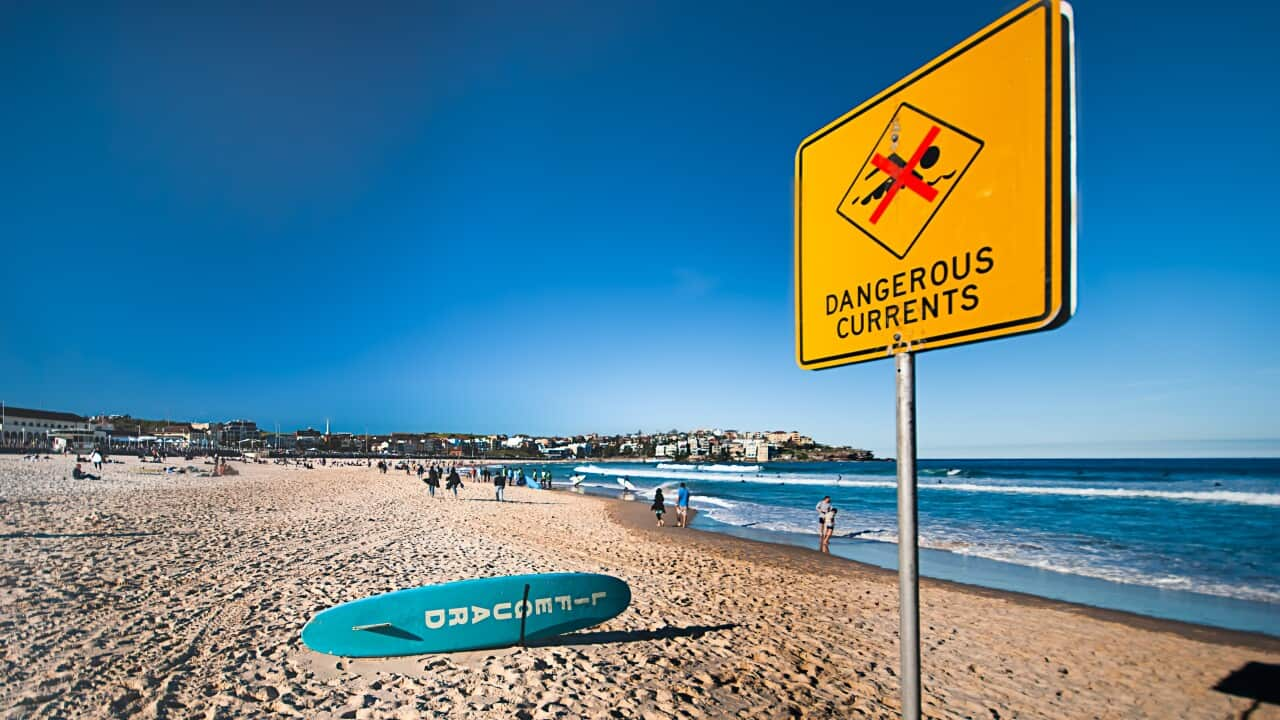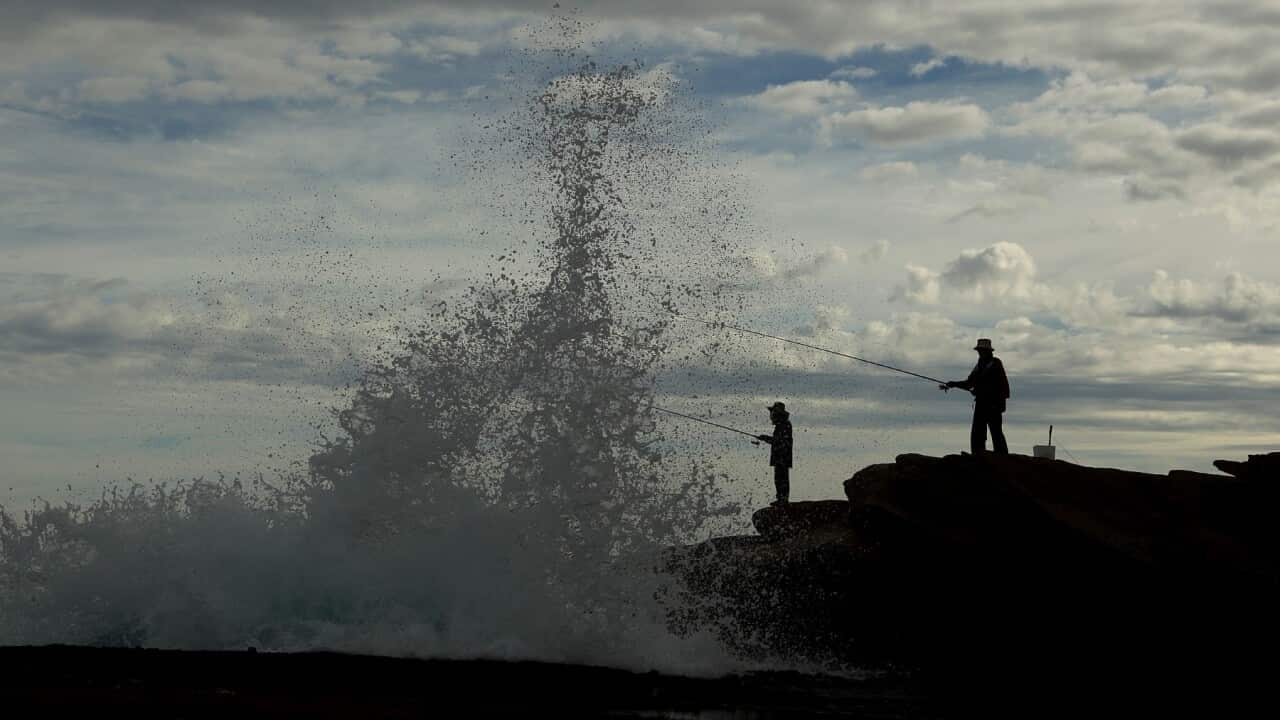Key Points
- Rip currents are Australia’s number one beach hazard
- The safest place to swim is at a patrolled beach between the red and yellow flags
- Australia has some of the world’s strongest shark mitigation strategies in place
- Tools are available to keep us ‘shark smart’
Last year Surf Life Saving Australia (SLSA) performed 10,000 rescues, with a high percentage due to dangerous ocean currents.
“Rip currents are the number one hazard on our beaches, and account for almost a quarter of all drowning deaths around Australia,” says Shane Daw, General Manager of Coastal Safety at SLSA.
Last year we had 141 coastal drowning deaths, and about 36 of those were attributed to rip currents.Shane Daw, General Manager of Coastal Safety at SLSA.

water at Bondi Beach Sydney Australia looking dramatic at low tide with water swirling as swimmers and surfers enjoy summer day weather Source: Moment RF / Brendan Maher/Getty Images
Why are rips hazardous?
Rips are powerful channels of water that move in the opposite direction to the waves, pulling you away from the beach and out to sea.
However, they are difficult to spot.
When you see water without white surf you might assume that it’s the safest place to swim, but you’re probably looking at a rip.
“We have a saying,” says Mr Daw. “White is nice – so you see the rolling of white water; green is mean. And by that it means the green water generally is water that’s deeper and moving in a different direction.”
If you do get caught in a rip:
- Stay calm and conserve your energy
- Raise your arm and call out for help
- Float with the current – it could return you to a shallow sandbank
- Swim parallel to the beach or towards the breaking waves to escape the rip.
But the best advice is to swim where it’s safe.
Swim between the red and yellow flags
Tragically 76 per cent of drowning deaths last year occurred one kilometre from a lifesaving service.
Consider your own abilities and where possible, swim at a patrolled beach between the red and yellow flags. The flags signify a safe area that is supervised by surf lifesavers or lifeguards.

Untuk keselamatan Anda, dianjurkan untuk berenang di antara rambu-rambu peringatan keamanan di pantai Credit: Lee Hulsman/Getty Images
You can locate patrolled beaches at . Here you can also find safety tips in 100 languages.
Are sharks a real threat at our beaches?
Shark attacks are uncommon and sporadic events.
Even so, Australia records the second highest number of shark bites in the world after the United States, with an average of 22 bites a year over the past decade.
“Luckily of all those bites there’s only an average of one fatality a year,” says Dr Phoebe Meagher, Wildlife Conservation Officer at Taronga Conservation Society.
Dr Meagher curates the Australian Shark Incident Database that has recorded human—shark interactions since 1800.

Fin cutting ocean surface with surfers in background at sunrise Source: iStockphoto / Philip Thurston/Getty Images/iStockphoto
Sharks don’t find humans especially appetising and are opportunistic feeders.Dr Phoebe Meagher, Wildlife Conservation Officer at Taronga Conservation Society
“I don’t think they have the cognitive ability to discriminate between different mammals,” says Dr Meagher. “From the shark’s perspective it doesn’t matter if you’re a human, a seal or a turtle.”
In fact, very few of our 400 shark species are dangerous to humans.
Three species are of concern across New South Wales, Western Australia and Queensland: the white shark, tiger shark and bull shark. These three target species are difficult to predict and can result in fatalities.
“They’re like teenage kids in some respects,” says Marcel Green, Leader of Shark Programs with the NSW Department of Primary Industries.
“Every one of them behaves differently. But we have what we describe as some generalised movement patterns.”
Tigers and bull sharks are active at dawn and dusk for example, so swimming at these times carries greater risk.
Other species do bite us occasionally, especially if provoked. You might accidently step on a ‘wobbegong’ lying on the seabed, but they are relatively harmless.

GOSFORD, AUSTRALIA - NOVEMBER 13: North Avoca Beach is closed after a surfer was attacked by a shark on November 13, 2017 in Gosford, Australia. (Photo by Tony Feder/Getty Images) Credit: Tony Feder/Getty Images
Staying shark smart
Australia has some of the strongest shark mitigation programs in place to protect beach-goers while minimising harm to sharks.
You’ll find beaches with netted enclosures, aerial shark surveillance such as helicopters and drones, and beach sirens signalling you to leave the water if a shark is sighted.
Shark tagging is also used to transmit a shark’s location to a SharkSmart app in real time. State-based SharkSmart apps send shark alerts, patrolled beach locations and safety advice directly to your phones or smart watches.
SharkSmart resources are available online in NSW, WA and Queensland, with similar education campaigns in other states:

A member of the Surf Life Savers takes part in a Search and Rescue operation at Port Beach in North Fremantle, Western Australia, Saturday November 6. 2021. Beaches have been closed amid fears of a shark attack near Perth, with a man reported missing. (AAP Image/Richard Wainwright) NO ARCHIVING Source: AAP / RICHARD WAINWRIGHT/AAPIMAGE
“Little fish attract big fish,” says Marcel Green, “and big fish attract sharks.”
Surfers are encouraged to wear personal shark deterrent devices. State government subsidies are available in WA.
READ MORE

#1 Inviting friends | Beach safety















